Would you like to see this ships in-game?
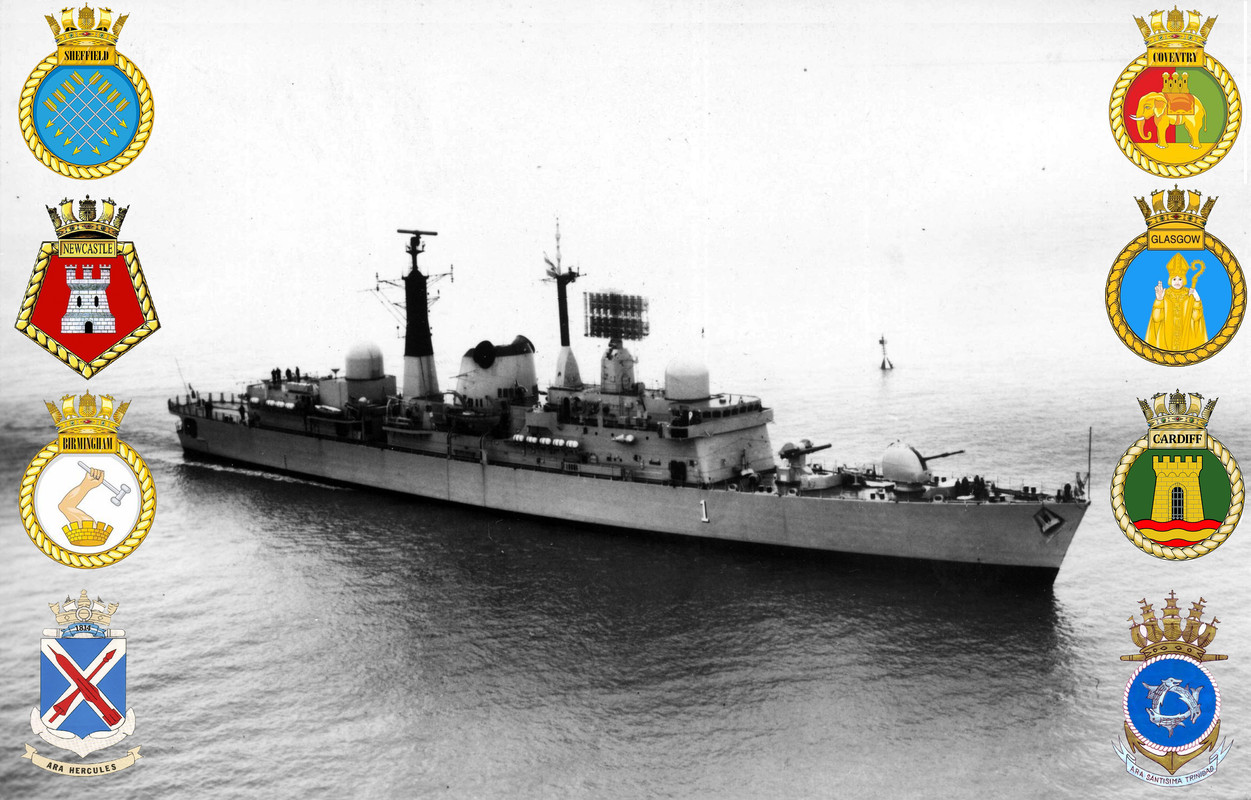
A Brief Introduction :
Today we’ll be talking about the Type 42 series of destroyers, more specifically the first batch of this class, 8 of this ships were built in between the late 60s and the mid 70s (1968-1974). These were the backbone of fleet missile defense and carrier escort for its both Users, the British and Argentine Navy, who both operated the Type 42 with minimal differences. With Naval forces slowly turning towards more modern frigates, its seems reasonable that we discuss the addition of Cold war Destroyers in a distant future.
In this suggestion we are going to cover each ship’s history and Service so we can have a better understanding of the class and its capabilities.
Here we will see various paragraphs depicting the story behind the class and its service
History and Service
Changes for the Royal Navy:
One of the major changes that steered the Royal Navy’s approach to its destroyers was the cancellation of the CVA-01 program, that consisted on a full sized carrier, and the termination of the Type 82 Program, although only one ship of the class was built (HMS Bristol). This were major budget cuts that forced the RN to reduce the size of the fleet, both in numbers and the size of said ships, of course this didn’t meant that the RN was going to reduce/loose its capabilities, as proposals and work related to the replacement of older systems never stopped during this years.
One of said Concerns was the replacement of the Sea Slug SAM, as this system was starting to become obsolete. The system chosen to replace the Sea Slug was known as GWS-30 “Sea Dart” a more compact and efficient system, able to reload automatically from an internal magazine and with a twin launcher design, the Sea Dart was seen as a more than suitable replacement for the Sea Slug. Another concern would rise regarding what ships would carry said weapon system, with initial proposals considering the fitting of a custom system (a bit smaller) to smaller sized frigates, this was later discarded, considering that the missile system required a large space for its magazine and the specific radar it was supposed to direct it.
Sea Dart saw itself being fitted to the larger Type 82 first in 1973, this served as a learning experience regarding the space concerns of the missile system (magazine + mechanisms) and how it operated. With this at hand, the concept of a “Sea Dart frigate” was completely discarded, and the design for the new ship focused to be a Destroyer.
The conception of a New destroyer:
The idea of the new destroyer found itself under major budget restrains, the cost of the recently built type 82 (17 million pounds) was considered excessive. The British government tried to get an effective cost reducing measure eliminating certain equipment’s to “bring its price down”, considering this, there were certain systems that were assumed indispensable to the new design, in between this there were the 4.5 in main gun (the Mk.8), the same radars and the Type 184 Sonar, a helicopter hangar and the already mentioned Sea Dart SAM. On the other hand, the Mk.10 ASW mortar and the Ikara missiles were not considered for the new design, as its job could have been taken by a Helicopter operating from the ship.
Even though the project saw a lot of designs in the form of Sea Dart armed frigates, the course taken was to make a “downscaled” version of the Type 82, the smaller size and the elimination of the unnecessary systems meant that it could retain an affordable cost while still being a capable ship. One of the major points taken forward with the Type 42 (something that the frigate-like design didn’t have) was a combined turbine propulsion, something that made the Type 42, more efficient at sea, easier to maintain and it required less crew for its operation.
The final price of the Type 42 was 11 million Pounds, this was a major difference when compared to the 17 million of the Type 82, but as the pricing was lower, it meant that the Type 42 had to take various compromises in order to reduce the price so much. Things like Close in weapons were reduced to x2 ordinary 20mm Oerlikon Cannons, things like Satellite communications and other important characteristics regarding the ship’s construction and protection were not included or simply recycled from the other classes (Leander).
The result was a ship that for some, it was considered to be lacking in certain aspects, Close in defenses, NQV & fire protection were lacking or insufficient for the initial type 42 (Sheffield), another aspect that suffered compromises was crew comfort, something that was seen as inevitable, as almost all the space available in the Type 42 was used, thus leaving little in terms of accommodations for the crew. Despite this with the Type 42 would go to production and fix a few of this issues after the first example.
Early days:
Having been ordered in 1968 and in 1970, the first ships (HMS Sheffield and ARA Hercules) were built south of Cumbria, at the same time a third example was being built in Argentina by Astilleros Río Santiago (ARA Santisima Trinidad). The remaining five ships were going to be built in Birkenhead by Cammell Laird (HMS Birmingham and HMS Coventry), Swan Hunter on Tyne (HMS Glasgow & HMS Newcastle) while the last example (HMS Cardiff) was partially built by Vickers and later finished by Swan Hunter. All ships after Sheffield would differ in few aspects, mainly the elimination of the exposed smoke funnels (so called Micky mouse ears) and fitting proper NQB and other protection from the start.
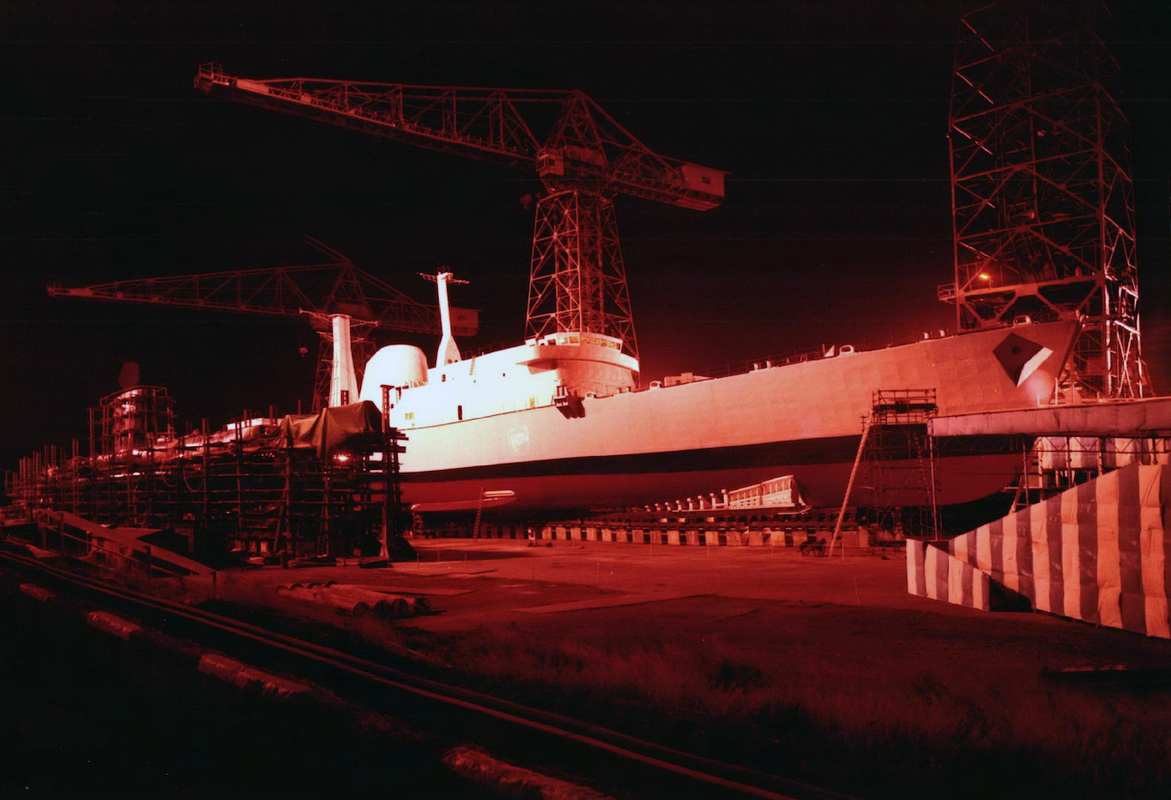
One of the early examples under construction
The Ships on their first years were seen being deployed to various points around the world in patrols and exercises, examples being HMS Birmingham being deployed in the Persian Gulf during the Iran-Iraq war in efforts to protect Oil shipping in the early 80s, or HMS New Castle and its deployments to the Caribbean/West indies. The ships of this class would later find themselves in a combat situation when a conflict would start in the South Atlantic, just of the coast of South America.
On South America, only one of the 2 Argentine Type 42s (Hercules as Santisima Trinidad was not finished until 1981) was seen deployed during the Beagle crisis, when the border definition between Chile and Argentina was questioned and this created tensions, so much that forces from both sides prepared for war, Hercules was deployed along ARA 25 de Mayo in efforts to provide Aerial Cover for the carrier and the Force that headed south. Thanks to Papal intervention, this conflict was avoided and tensions calmed.
Showdown in the South Atlantic:
Following a Tensions with Uk, the 2nd of April an Argentine Force composed invaded the so called Falklands/Malvinas Islands, in this force there were two Type 42 Destroyers, ARA Hercules and ARA Santisima Trinidad, both supporting the deployment of special forces and Helicopters for the initial operation under the name “Rosario”. Following the Surrender of the Royal Marines Garrison in the islands the 2 Ships would be assigned as escort of the Colossus class Carrier ARA 25 de Mayo, this being their role in the war until the end in June.
In response to this The British government assembled a task force to respond to the Argentine invasion, on said force there were 5 Type 42s, HMS Sheffield, HMS Coventry, HMS Glasgow, HMS Cardiff and HMS Exeter (This was a batch 2 ship, so its participation won’t be covered on this post). Initially 3 Type 42s arrived to the south Atlantic, HMS Sheffield, HMS Coventry and HMS Glasgow, later HMS Cardiff and HMS Exeter would join.
To get a better perspective, we are going to see each ship actions during the conflict.
HMS Glasgow (D88)
Spoiler

At the time of the invasion HMS Glasgow was participating in exercises in Gibraltar, when it was ordered to join the other ships (this being the other 2 Type 42s and 4 other ships) that were going to be deployed in the retaking of the islands. Along its sisters, Sheffield and Coventry, they sailed towards the South Atlantic.
Glasgow saw its first action (and the first combat action by any of the British type 42s) on may 2nd, when its Lynx helicopter attacked and mortally wounded Argentine Auxiliary ship ARA Alferez Sobral, who was impacted by 3 Sea Skua missiles while it was performing a search for 2 lost pilots on the sea, the Argentine Ship would survive the attack.
Two days later on May 4th Glasgow would anticipate the Argentine attack by the 2 Super Etendard aircraft after they were detected, a combination of fatigue, negligence and the command not considering this to be a real attack ended up in the loss of HMS Sheffield (leaving only 2 Type 42s on the defense of the Fleet, the other 2 ships were going to arrive later at the end of May). this is best explained in the Part dedicated to HMS Sheffield
After the loss of Sheffield on May 4th, it was decided that the two remaining Type 42s were going to be paired with a Type 22 in efforts of providing a better aerial cover against Argentine aerial attacks. Glasgow was paired with HMS Brilliant, while the other Type 42 in the operations theater HMS Coventry was paired with HMS Broadsword, this created the so called “Missile trap”, combining the long Range SAM in the Type 42s (SEA DART) and the deadly short range SAM of the Type 22s (SEA WOLF) making the new pair a formidable opponent that could engage efficiently the arrival of any attacker, at long or short ranges with devastating results.
The Glasgow-Brilliant couple was the first of the two to be deployed close to the islands, with the intent of bombarding Argentine positions, while also draw Aerial attacks off the main force. And as expected, on may 12th, the pair went under attack by a x4 A-4P Skyhawks from Grupo 5 while the ships were bombarding BAM Malvinas (the main Argentine base on the islands), the Sea Dart system on Glasgow would fail, leaving only the Sea Wolf system in Brilliant to provide protection for both, 2 of the attackers would be shot down while another one crashed against the water while trying to evade debris.
Another Wave of Skyhawks would arrive for a second attack, this time the Sea Wolf failed, and the attackers managed to hit both ships with 1000lb bombs, although the bombs failed to explode, the one that hit Glasgow passed through and seriously damaged the ship’s power plant, leaving only one turbine operational and restricting the speed of the ship to 10 knots. The damage sustained by Brilliant was light.
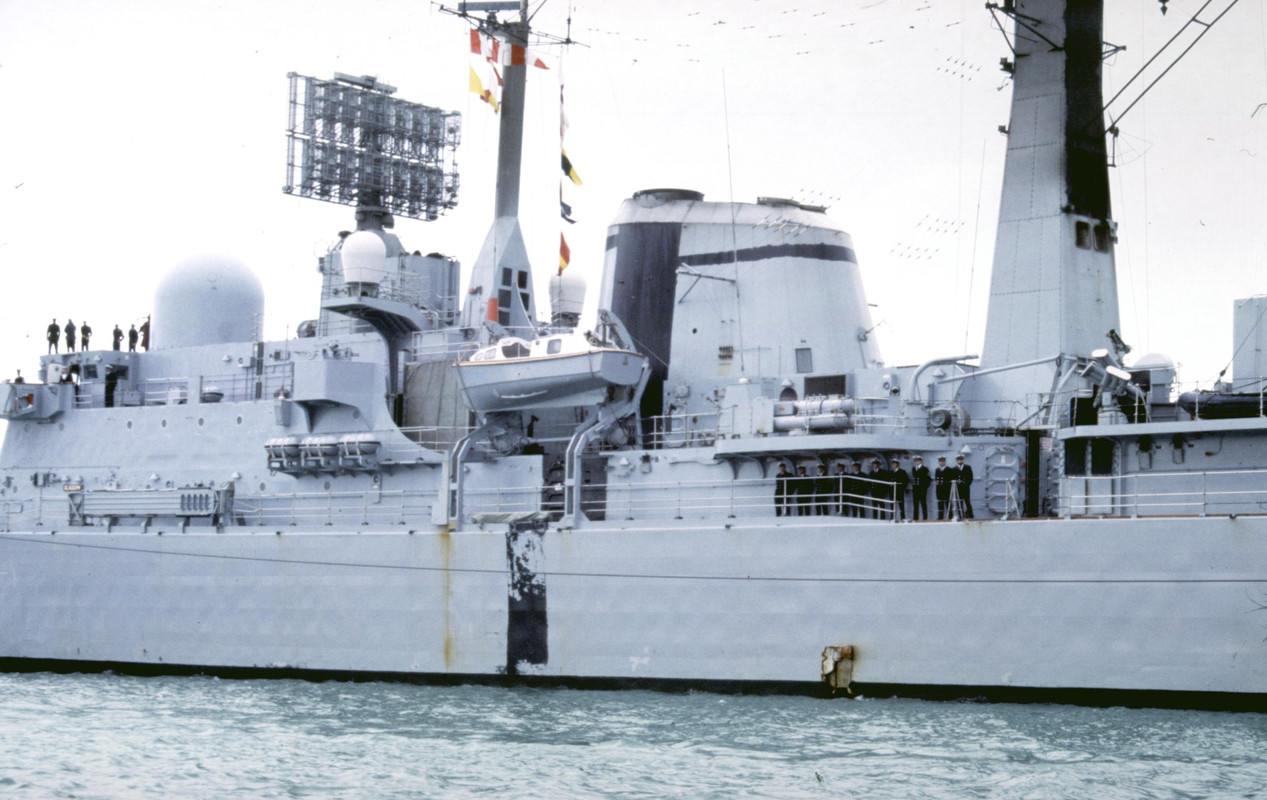
On its return trip, with the exit hole patched
With its speed limited and undergoing repairs to plug the large holes provoked by the bombs, Glasgow was deemed Inoperable for the reminder of the conflict and removed from the theater of operations, being the first ship to do so.
HMS Coventry (D118)
Spoiler

Coventry was also taking part in the exercise in Gibraltar during the Argentine invasion, and like its sister ships, it was sent to the south Atlantic with the initial Task force. Their arrival to the islands was made on April 27th when they entered the exclusion zone.
Much like Glasgow, Coventry’s Initial combat operations would begin with the attack on the Argentine Auxiliary ship ARA Alferez Sobral, where an helicopter from each ship fired 2 missiles at the Tugboat, provoking mortal damage and leaving it for sunk afterwards (like we mentioned earlier, the Argentine ship survived).
With the loss of HMS Sheffield, Coventry was paired with HMS Broadsword. While these 2 ships were paired, Coventry was the first ship to fire Sea Dart missiles against Argentine Aircraft, when it fired 3 missiles at 2 Argentine Reconnaissance Lear Jets from Fenix Squadron, none of the missiles hit. On May 9th it would achieve its first aerial show down, when it managed to down an Argentine Army Puma Helicopter over Choiseul Sound.
After the May 12th Aerial attacks and the subsequential damage suffered by both ships (thing that rendered the HMS Glasgow out of action), Coventry and Broadsword were deployed forward to replace the other pair. Like Glasgow and Brilliant before them, the new pair was tasked with the same forward air defense and attacking ground positions. Both ships would be deployed north of the islands, Coventry then would manage to down 2 aircraft that passed close while coming back from their missions, this concerned the Argentine Air Force command, who would order an attack on the pair on May 25th.
The attack would arrive in the form of 4 A-4P Skyhawks from Grupo 5, on waves of 2, the first would target Broadsword while the remaining 2 would attack Coventry (its important to know, that the first 2 attackers were carrying a single 1000lb bomb each, while the last 2 were carrying x3 250kg bombs each). During the close in of the Argentine Aircraft, the radar on both ships would fail, leaving the 20mm and 7.62 machine guns on both ships as their only defense. Coventry would fire an unguided Sea Dart missile, in efforts to scare away the attackers, but this proved to be futile. The first 2 aircraft managed to hit Broadsword with one bomb, where it entered from one side of the ship and it would exit through the deck towards the sea (tearing the nose of a helicopter in the process). While the 2 remaining aircraft were closing in for their attack, Broadsword Sea Wolf system came online, but sadly Coventry was blocking the line of fire.
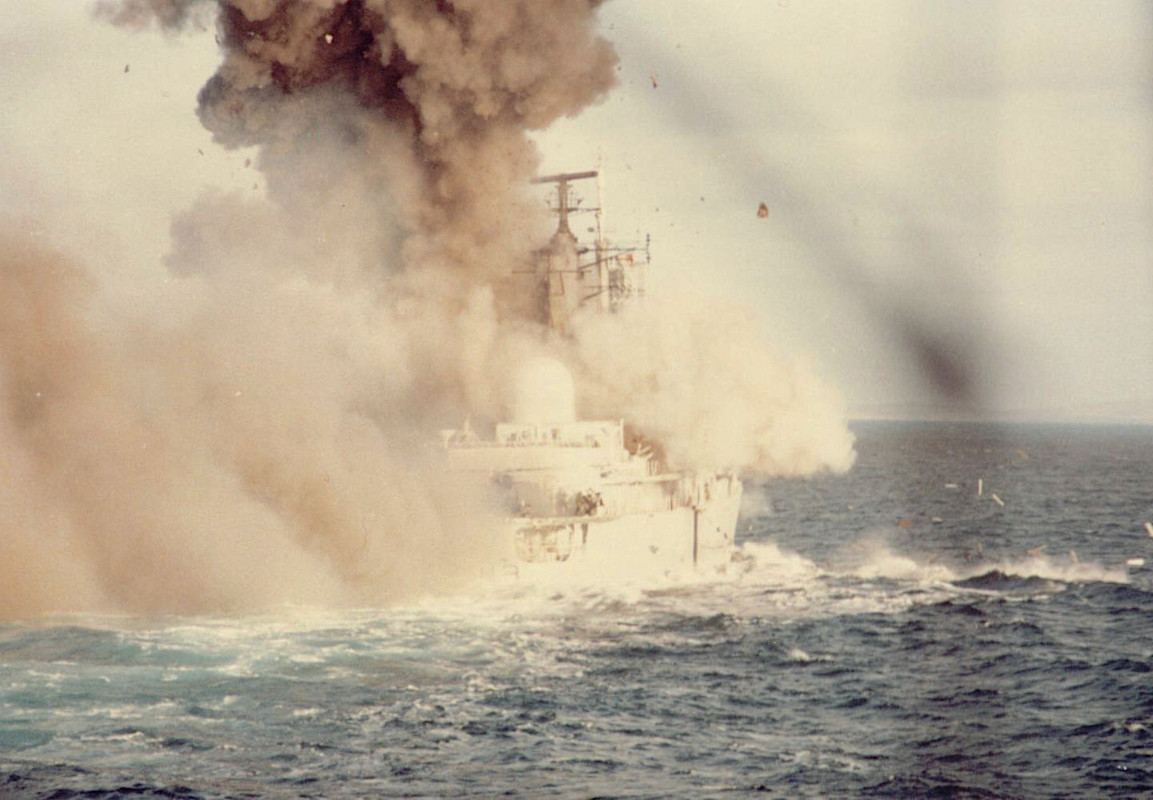
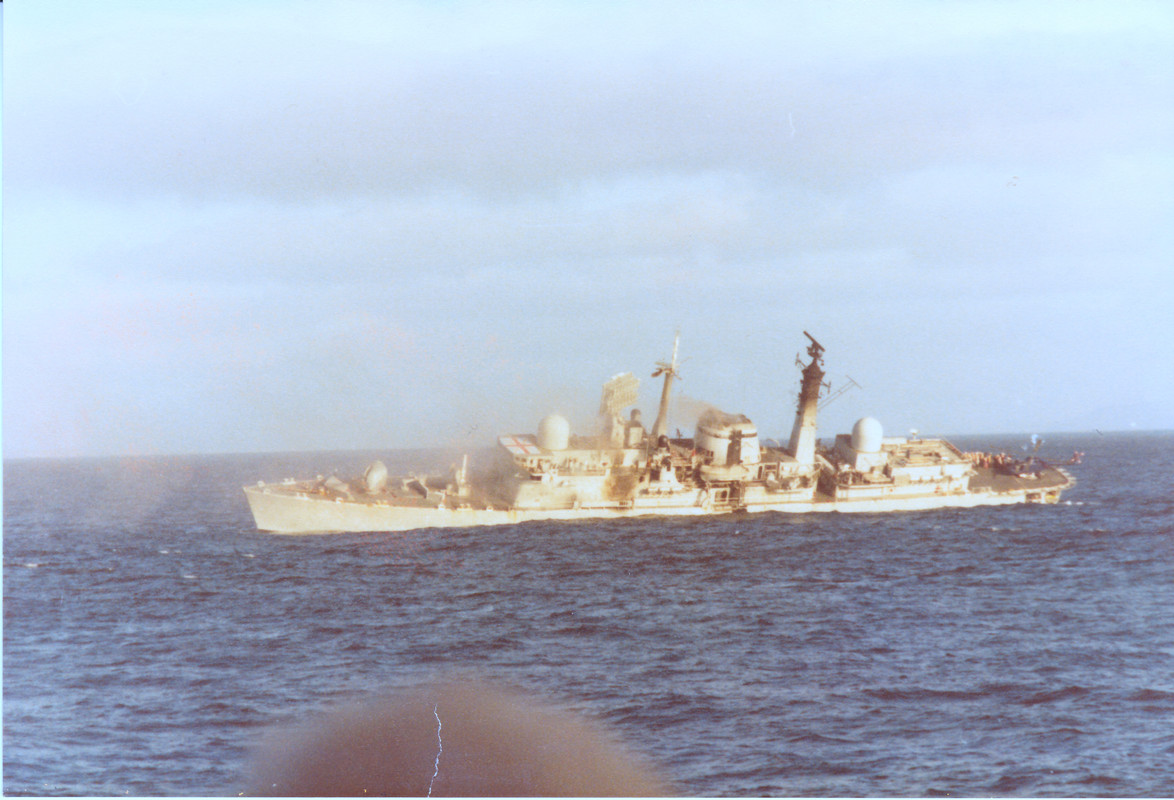
Pictured HMS Coventry as the 250kg bombs exploded and moments after as it was capsizing
Coventry would be hit by x3 250kg bombs, a large hole was tore open over the waterline on the port side, this provoked an uncontrollable flooding. As the ship took more water it started capsizing and the ship’s captain ordered the crew to abandon the ship. Coventry would completely capsize and sunk in less than 20 minutes, while its crew was rescued by Broadsword.
HMS Sheffield (D80)
Spoiler
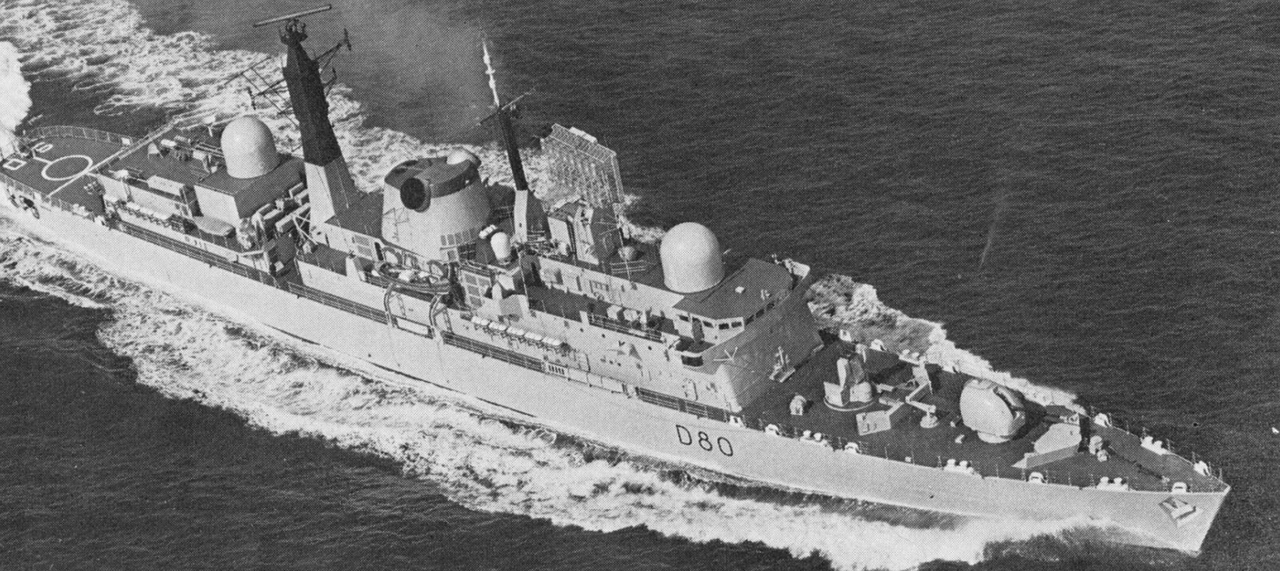
Sheffield was the third and last type 42 that was participating in the Gibraltar exercises, and like its sisters, it was ordered to join the Task force that headed for the islands, departing the 10th of April, and like mentioned before arriving on April 27th.
During this time Sheffield and the other Type 42s would act as “Goalkeepers” , this meant they were going to be the Major air defense ship that could defend the fleet at longer ranges, all thanks to the powerful radars and the Sea Dart missiles.
During its initial days in the combat theater Sheffield was detected by an Argentine Navy SP-2H Neptune maritime patrol aircraft on the morning of May 4th. The Argentine aircraft’s mission was to act as an early warning for the C-130 Hercules that were sent to resupply the Argentine Forces. As Soon as the aircraft stumbled upon Sheffield and the fleet, the crew of the Neptune informed of the threat to the COAN (Naval Aviation Command), this would led to the scramble of 2 Dassault Super Etendard Strike aircraft, armed with the AM-39 Exocet Anti Ship Missile.
The fleet was on “Warning yellow”, with no indication of the presence of attackers, at the same time the Argentine Neptune was guiding the Super Etendards, after the guidance of the Neptune ended, the Attackers lowered their altitude to 25 meters. At around 50 Nautical Miles from the objective both aircraft popped up and turned their radars on to acquire an objective, something that they failed to do, thus returning to 25m.
The electronic warfare operator inside HMS Glasgow detected the radar Pop Up, and proceeded to inform “AGAVE BEARING 238, CONFIDENCE LEVEL CERTAIN” (Agave being the name of the SUE radar), both aircraft had been detected during the initial “pop up”. Action stations were ordered on HMS Glasgow, again the operator passed “FLASH, AGAVE 245, CONDOR 245”, HMS Sheffield would receive part of this message, but it wasn’t taken seriously.
At around 30 Nautical Miles from the fleet, the Super Etendards popped up again and turned their radars on. Again HMS Glasgow detected this and informed it again, HMS Invincible would give a ROGER OUT and retransmit the message via LINK-10, this message was only received by HMS Coventry, Invincible and Sheffield.
A minute later the Type 992 radar showed 2 the 2 incoming aircraft, again the operator informed “TWO LOW BOGIES, SW 25 NM, AIRCRAFT HEADING 070-080”. The operators gave the order to make Glasgow launch Chaff in efforts to draw the SUEs Radars attention.
The Operators inside Glasgow again contacted Invincible, who again gave a “ROGER OUT”, while Sheffield was ordered to prepare the fire director to engage the attackers.
The attackers would finally launch the 2 Exocet missiles, followed by the aircraft inverting their route, heading back to the continent.
The operators on Glasgow saw this and informed “FLASH, ZIPPO ONE, BRUISERS, INCOMING BEARING 238-12”. After this Invincible would order Glasgow to stop using Chaff and that the attack couldn’t be real, the desperate operator screamed over the intercom “NEGATIVE, THE FORCE IS UNDER ATTACK”.
At that precise moment the crew of Both Glasgow and Sheffield saw the 2 missiles coming towards them, sailors screamed over the Intercom “MISSILE ATTACK, HIT THE DECK”.
An enormous force hit Sheffield on its side as the missile smashed against the hull, followed by an explosion and black smoke coming from the large hole blown just above the waterline. The ships damage control team was split in 3, to fight the fire that had broke out, due to the extreme heat the automatic extinguishers melted and the loss of power by the ship meant the only thing left to fight the fire were a couple of hoses and water pressure bombs provided by HMS Arrow, who was assisting Sheffield.
After hours battling the fire, and this making its way towards the Magazine, it was ordered to abandon the ship. It would be towed outside the exclusion zone where it would sunk as water entered the hole left from the missile impact.
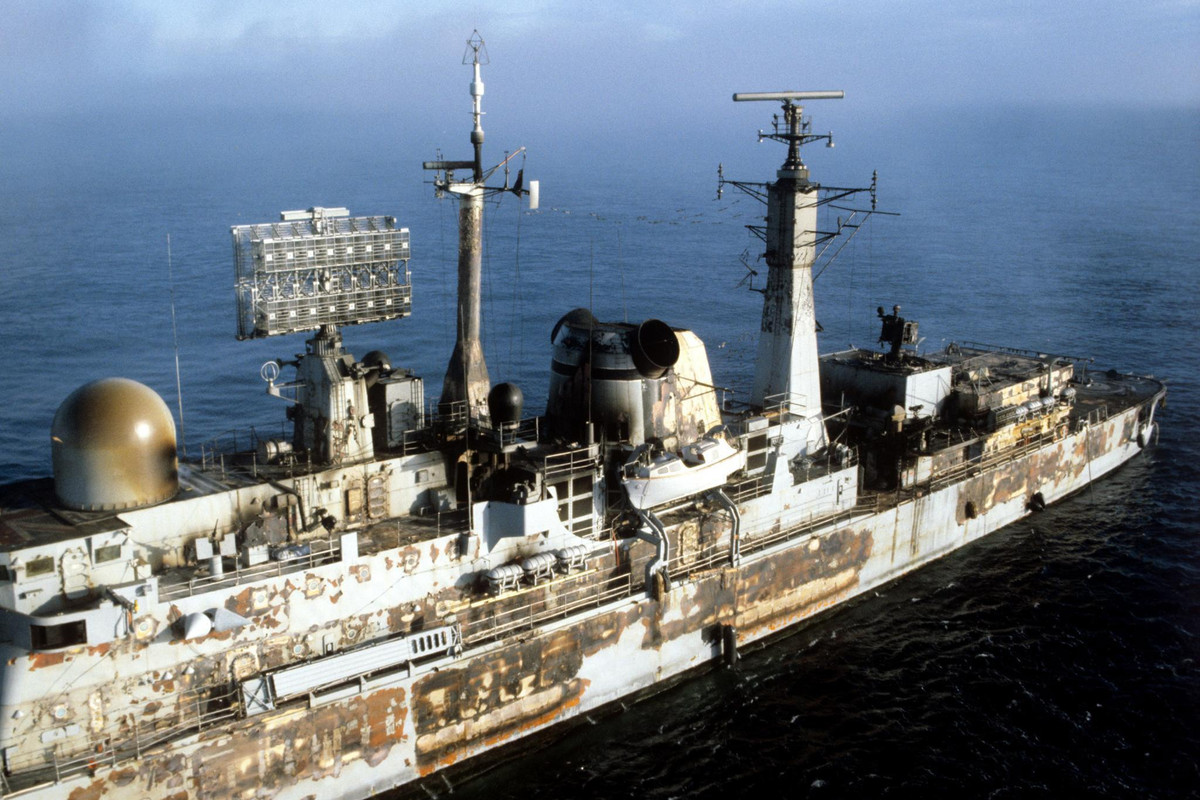
The captain of Sheffield would later arrive at HMS Hermes, where Admiral Woodward would tell him “I suspect someone’s been bloody careless”. The failure of the crew to detect and react to this fatigue, negligence or underestimation that the missiles wouldn’t be operational at that time in the conflict.
HMS Cardiff (D108)
Spoiler
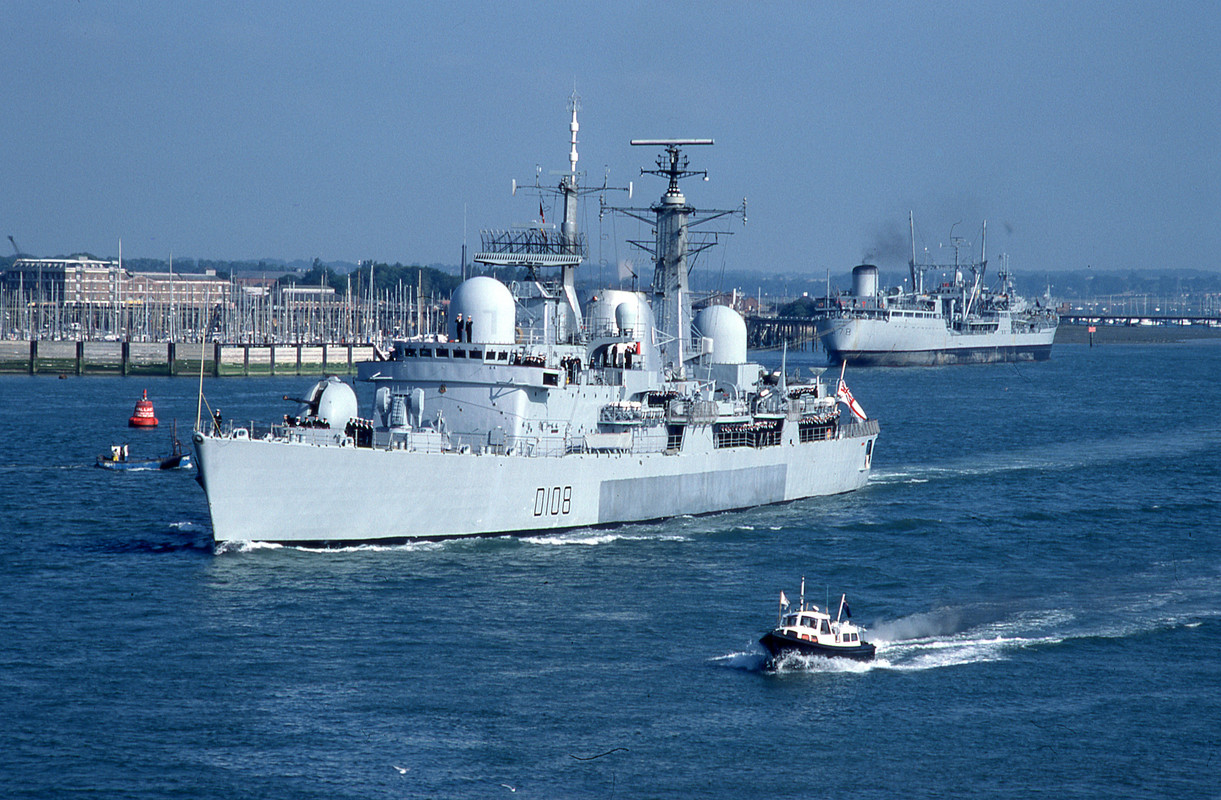
Cardiff was among the later arrivals to the conflict, among another Type 42 HMS Exeter (not covered because this is a batch 2) among other ships. During its trip towards the islands Cardiff would have a run-in with an Argentine Air Force Boeing 707, this aircraft was intended as a long range recon/patrol, that already had been caught surveilling the British fleet time before the arrival of the first ships to the theater of operations. Cardiff would fire its Sea Darts against the intruder, who proceeded to do an steep dive in efforts of avoiding the missiles, the 707 would escape Unharmed.
With the arrival of Cardiff on may 26th, Glasgow was finally allowed to retire to the Uk for repairs, who was kept among the fleet until the arrival of more ships. Much like the other Type 42s before, Cardiff was assigned the same role, Forward Aerial covering and to bombard Argentine positions when possible.
Cardiff would find itself under attack on June 13th, when 2 Argentine Air Force Mirage V “Daggers” would attack the ship its helicopter, with minimum consequences, given the bad weather conditions, the mirages couldn’t visualize well the targets. On the same day during the night, Cardiff managed to shot down an Argentine Canberra bomber, this being the last Aircraft to be shot down of the war.
After said events and the later surrender of the Argentine Forces, Cardiff was relegated to auxiliary roles until its return to the Uk.
Post war Period
Following the war, the main problems found with the original Type 42s were worked on, initially ships were fitted with more 30mm cannons, thing that was seen as insufficient, later all ships received CIWS systems to protect against close aerial attacks. The ships would alternate between Patrols/deployments/exercises in the West indies, Persian gulf, South Atlantic, Mediterranean and others worldwide, especially in the Falklands where tensions with Argentina Would rise again in the late 80s, but never to end up in another conflict.
In the early 90s with the invasion of Kuwait by Iraq, only one Batch 1 Type 42 was deployed along coalition forces, this was HMS Cardiff, who was deployed along batch 2 and 3 Type 42s to provide protection for United States navy Carriers, the boarding of suspected vessels and attack of surface vessels by their Lynx Helicopters. This helicopters would destroy various Iraqi minesweepers and patrol boats that were trying to escape towards Iran.
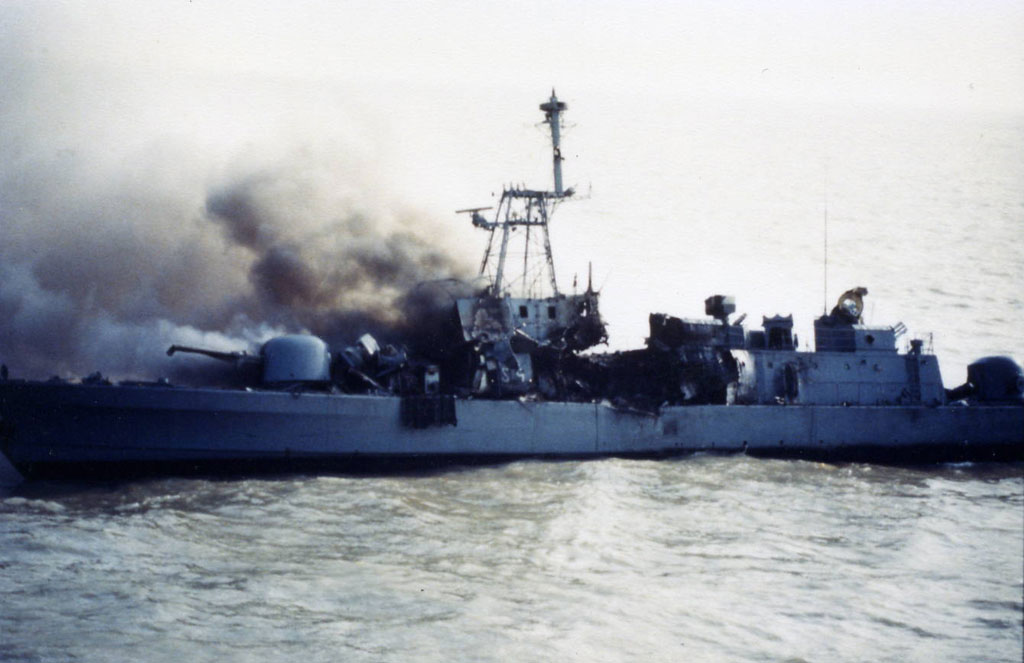
An Iraqi Gunboat after being hit by a Sea Skua missile
The other Type 42 to be deployed in another conflict during the 90s was HMS Newcastle, who was appointed HMS Invincibles’ escort during the Balkan wars, providing cover against any aerial attacks.
On south America, the Argentine Type 42 would remain operational with major difficulties regarding the availability of parts, until the 1990s, when ARA Hercules was transformed into an tactical transport ship and Santisima Trinidad would be cannibalized for spare parts.
Last years
Towards the end of the 90s and the early 2000s the type 42s started becoming difficult to maintain, this was fist saw when Birmingham was decommissioned during the late 90s and cannibalized for parts, the ship being scrapped in 2000, this would continue, as by 2005 all Batch 1s were retired from service and retained for parts. As most of their major components were retired over the years they were sent to be finally scrapped in late 2008.
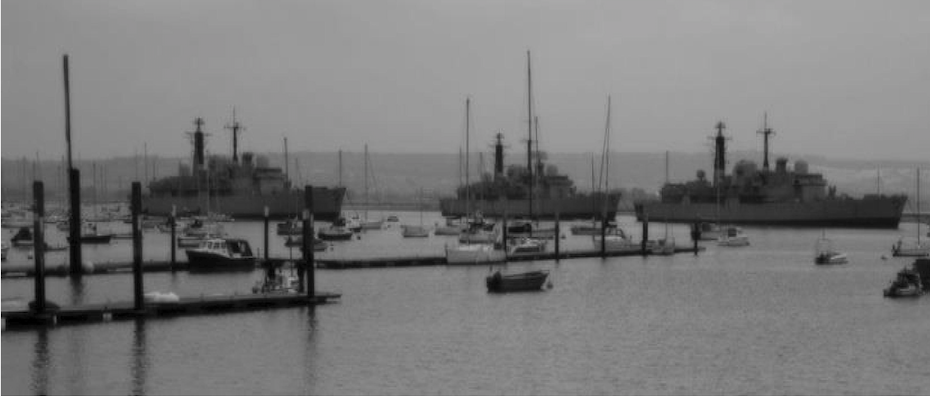
Final picture of the batch 1 type 42s before departing towards their scrapping
From the 2 Argentine Ships, Only Hercules survives and its kept on service, while Santisima Trinidad suffered a major accident when it capsized on port and it was deemed unusable and its undergoing disposal.
Specifications:
Spoiler
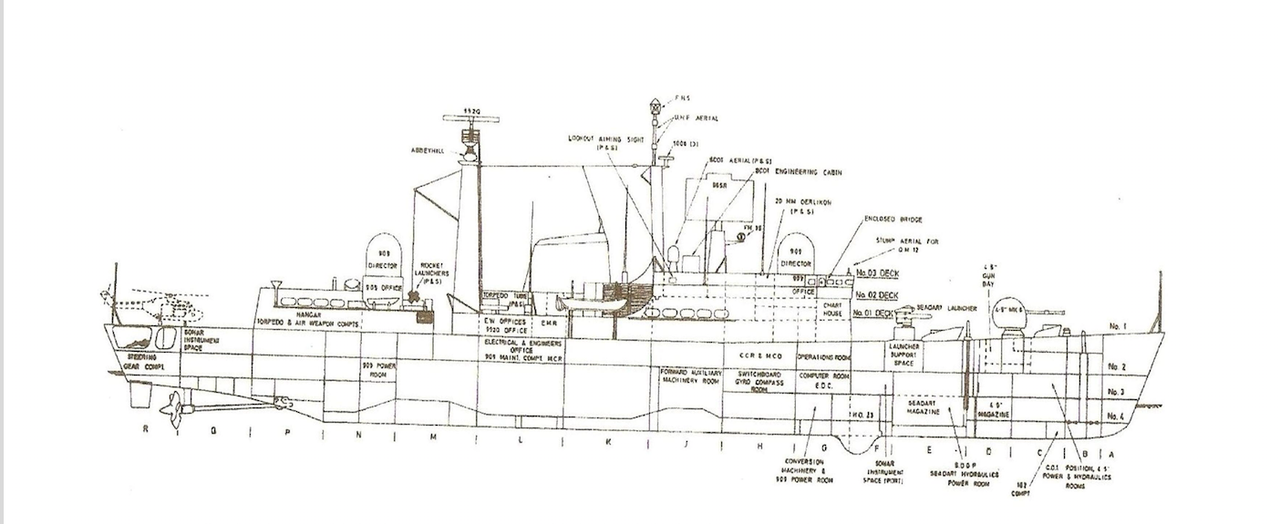
General Characteristics:
Displacement:
3600 Tn (Standard)
4200 Tn (Full)
Dimensions:
Length: 126 m
Beam: 14.3 m
Draft: 4.2 m
Propulsion:
×2 Rolls-Royce Olympus TM3B high-speed gas turbines, (50,000 shp)
×2 Rolls-Royce Tyne RM1C cruise gas turbines, (5,340 shp)
Power 50000 SHP
Speed:
Max speed: 30 knots
Average speed (depending on power plant): 18-23 Knots
Range: 4200 nautical miles at 14 knots
Crew: 253 people
Sensors and systems:
- Radar Type 1022/965P air surveillance
- Radar Type 996/992Q 3-D surveillance
- Radar Type 909 GWS-30 fire-control
- Radar Type 1007 &1008 navigation
- IFF 1016/1017
- Sonar Type 2050 / 2016
- Sonar Type 162
- Corvus Countermeasures (CHAFF)
Armament:
The armament carried by the Type 42 consisted on a gun system (the Mk.8), an SAM system (Sea Dart), torpedoes and some light AA platforms.
Main Armament: (Mk.8)
The main gun of the Type 42 was the Mk.8, a remote controlled 114mm gun that had an automatic reload system and it could fire variety of ammo choices.

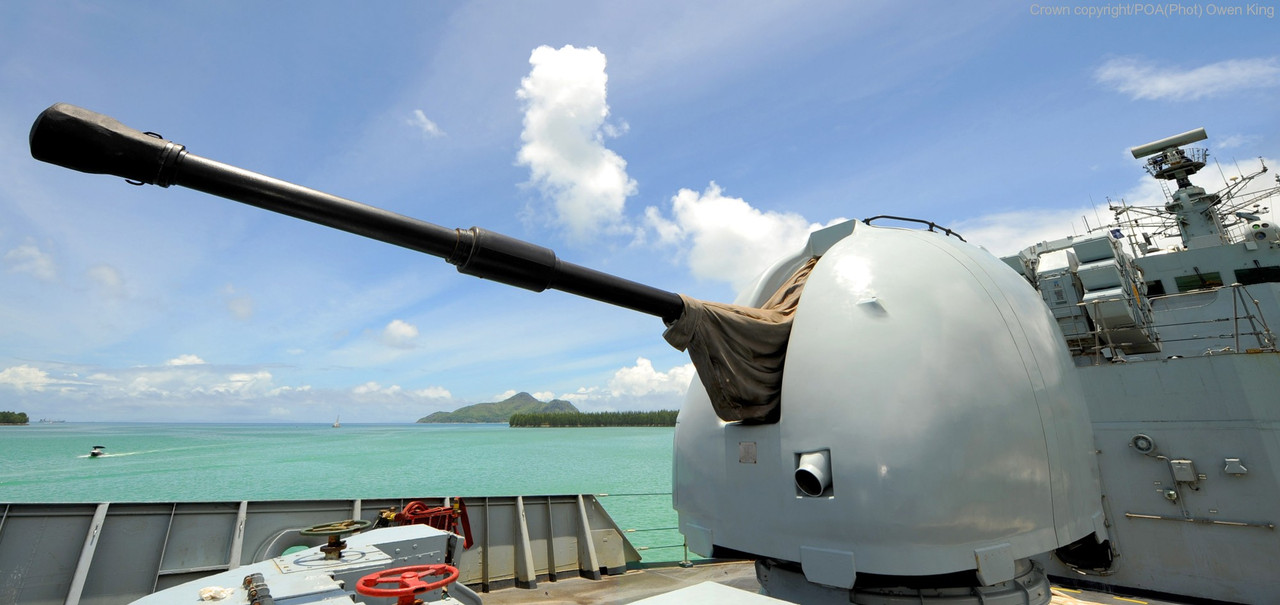
Specifications:
Caliber: 114mm
Weight: 2.4 Tn
Length: 6.2 m
Rate of fire: 20-26 RPM
ammo types: HE, CHAFF, Illumination rounds, HE + Proximity fuse.
A-A Armament: (Sea Dart)
The sea Dart missile system was the Type 42’s main defense mechanism against aerial attacks, the system itself was very large, and it occupied a very substantial portion of the Ship’s hull. The system can be described fairly easy, as in pictured below we can identify each part and its function.
- The part at the top is the Launcher itself (GREY), this has 2 “Arms” that are meant to hold the missile and direct it prior to being fired.
- On light green, we are going to see the Elevators, this were the system’s form of “reload”, as missiles were fired, the launcher aligned itself with 2 holes in the deck, where 2 rails feed each missile to the launcher.
- Lower and this time in red, we can see the “baskets” that carried each missile, towards both rails and feed them to the Launcher.
- Lastly in white, we have the Sea Dart missile itself.
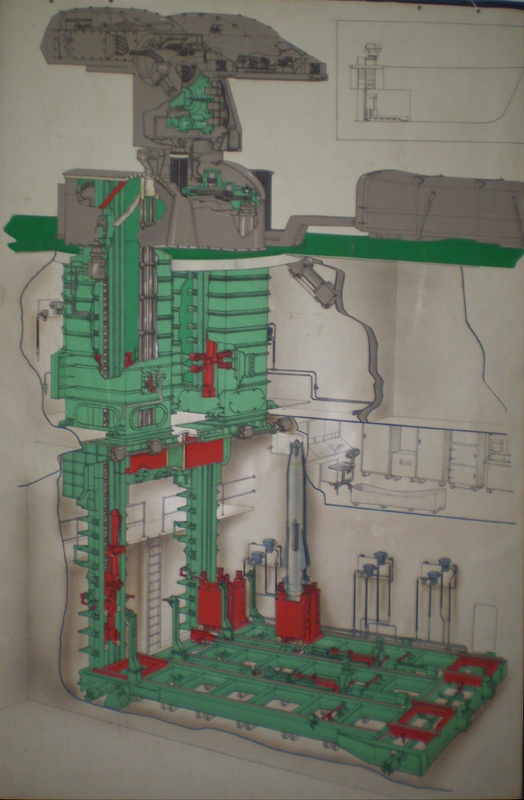
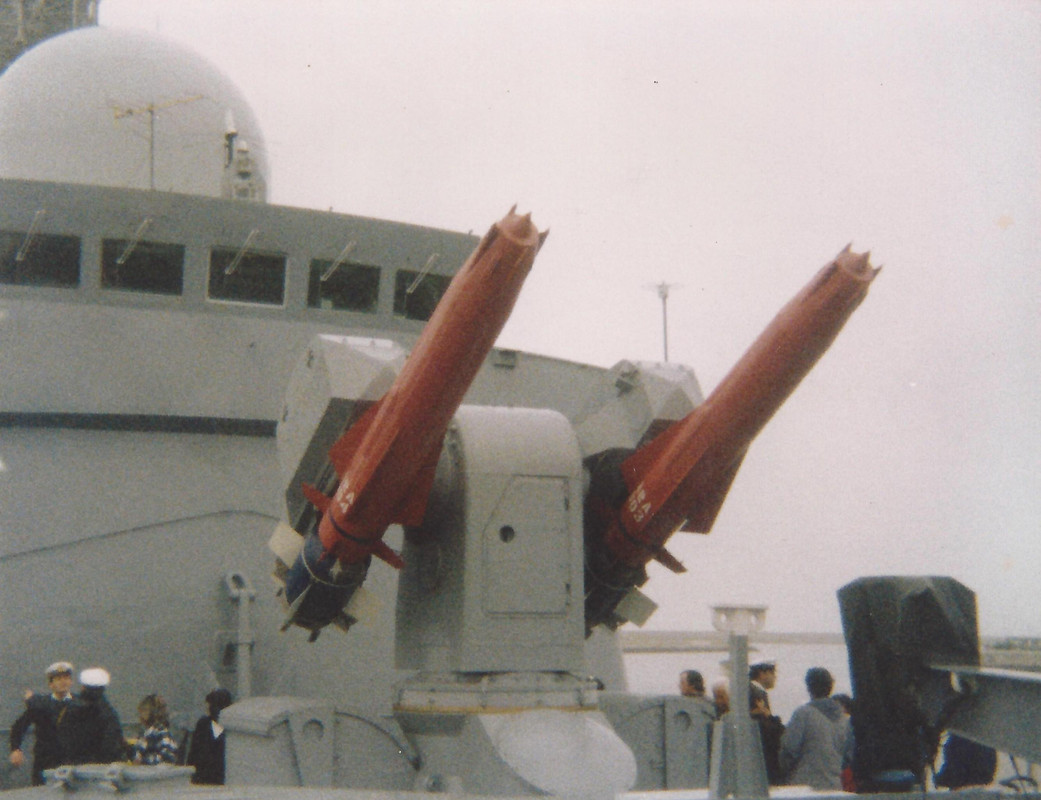
Specifications:
Length: 4.3m
Diameter: 0.42m
Weight: 554 kg
Payload: 22.7 kg (HE)
Range: 45-55 km
Max speed: MACH 2+
Torpedoes:
The Ships had 2 triple torpedo launchers, this were meant to be used against submarines and other vessels.
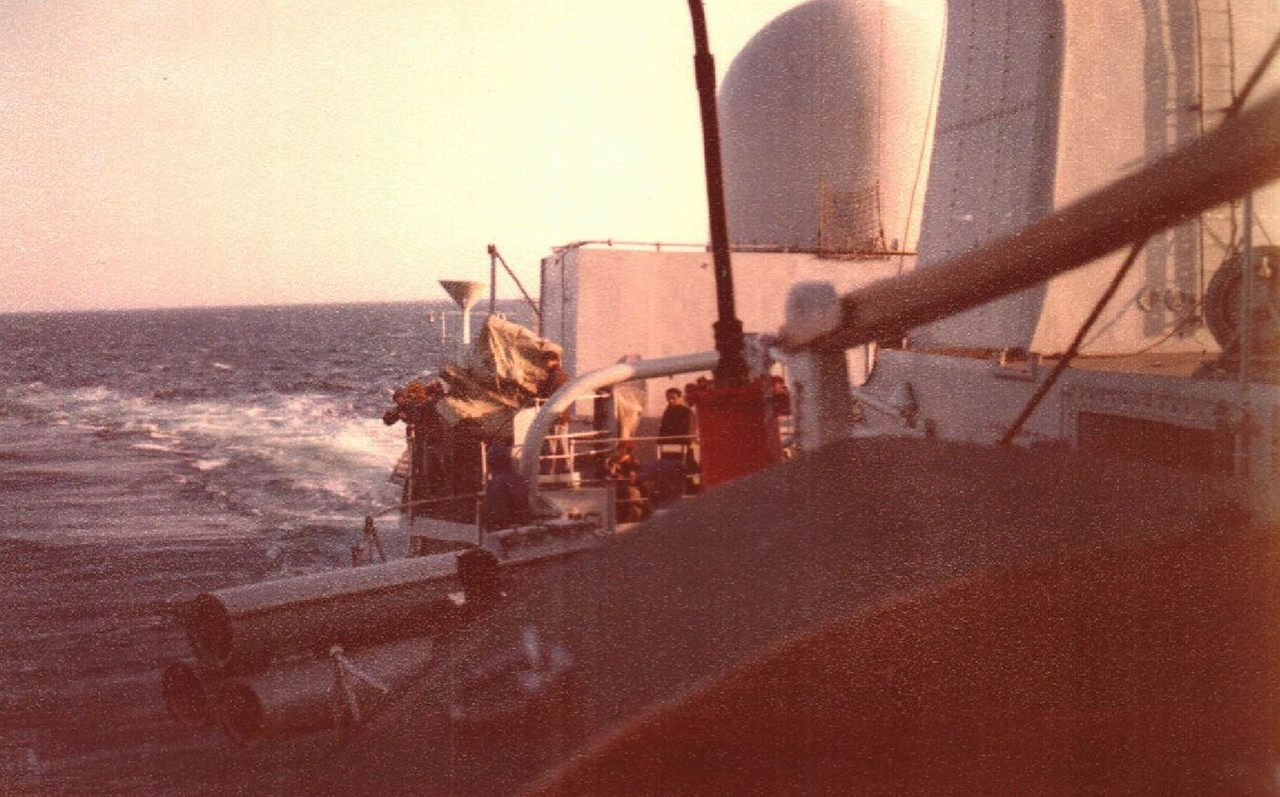
Its Characteristics:
Height: 1.2 m
Width: 0.93 m
Length: 3.5 m
Launch Radius: 110 degrees
Torpedoes used:
Other:
x1 Lynx Helicopter (or Alouette/Scout).
x2 or more FN Mag machine guns.
Upgrades:
+x2 20mm single tube Oerlikon Cannons
+x2 Phalanx CIWS system (post 1982)
+x4 MM38 Exocet missiles (Argentine examples only)
Images:
Spoiler
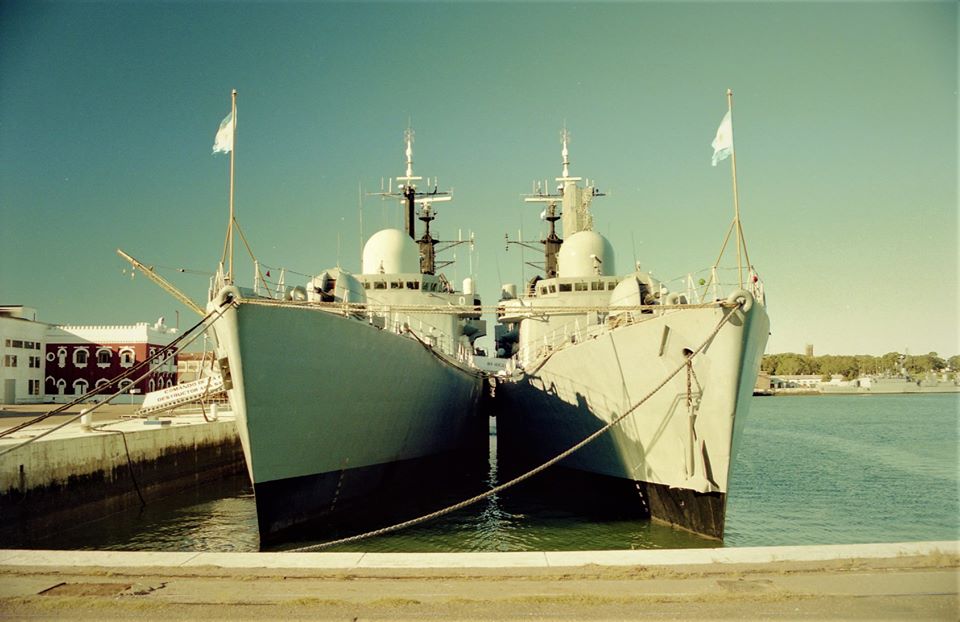
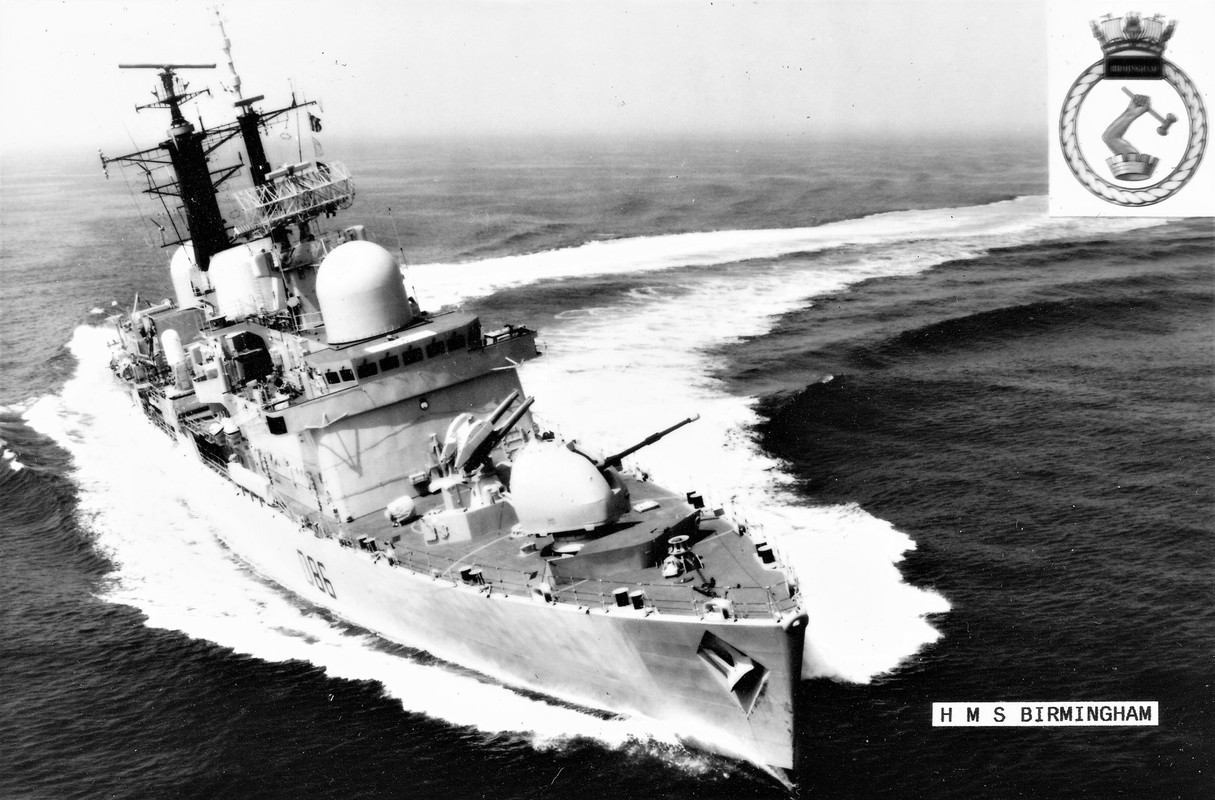




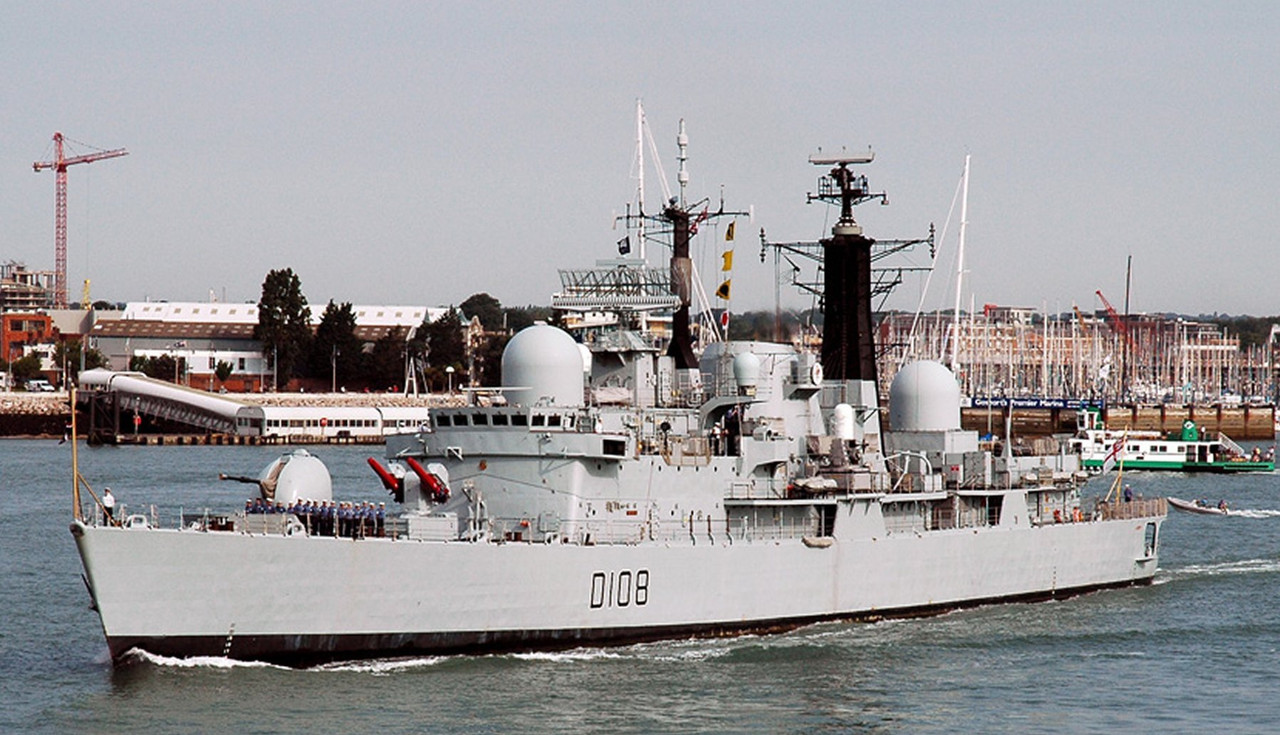
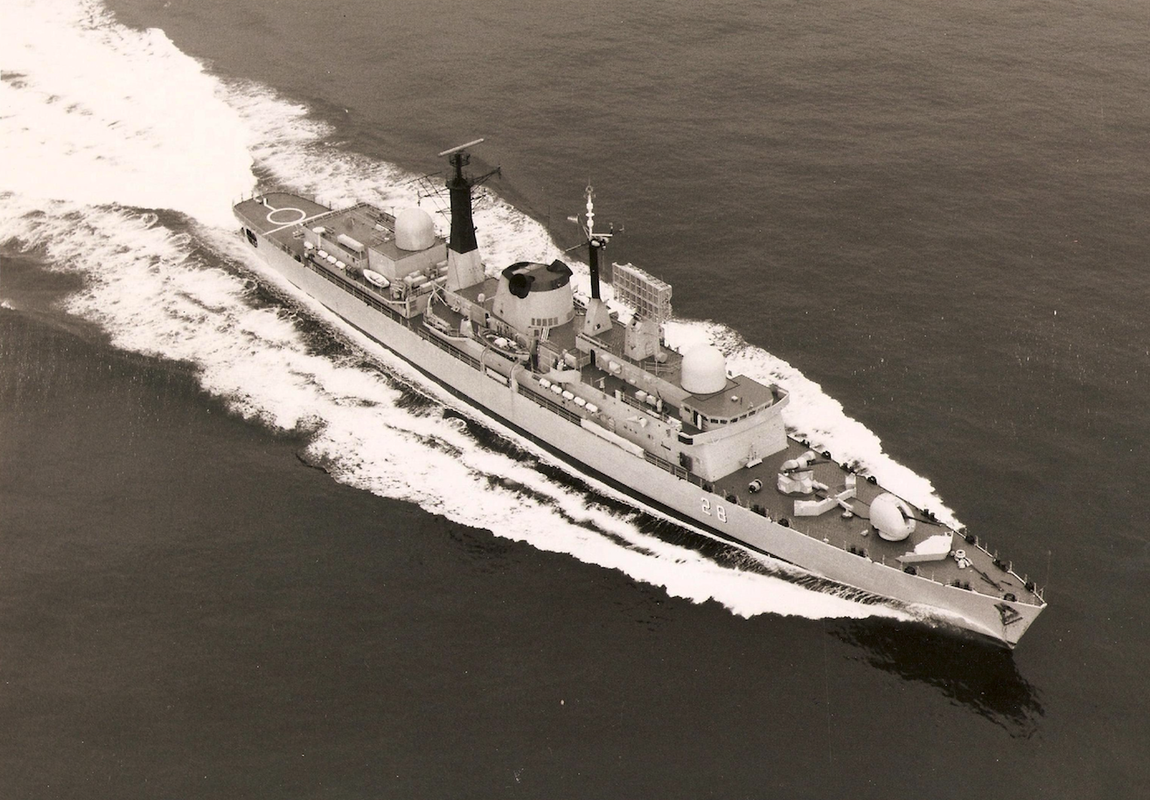
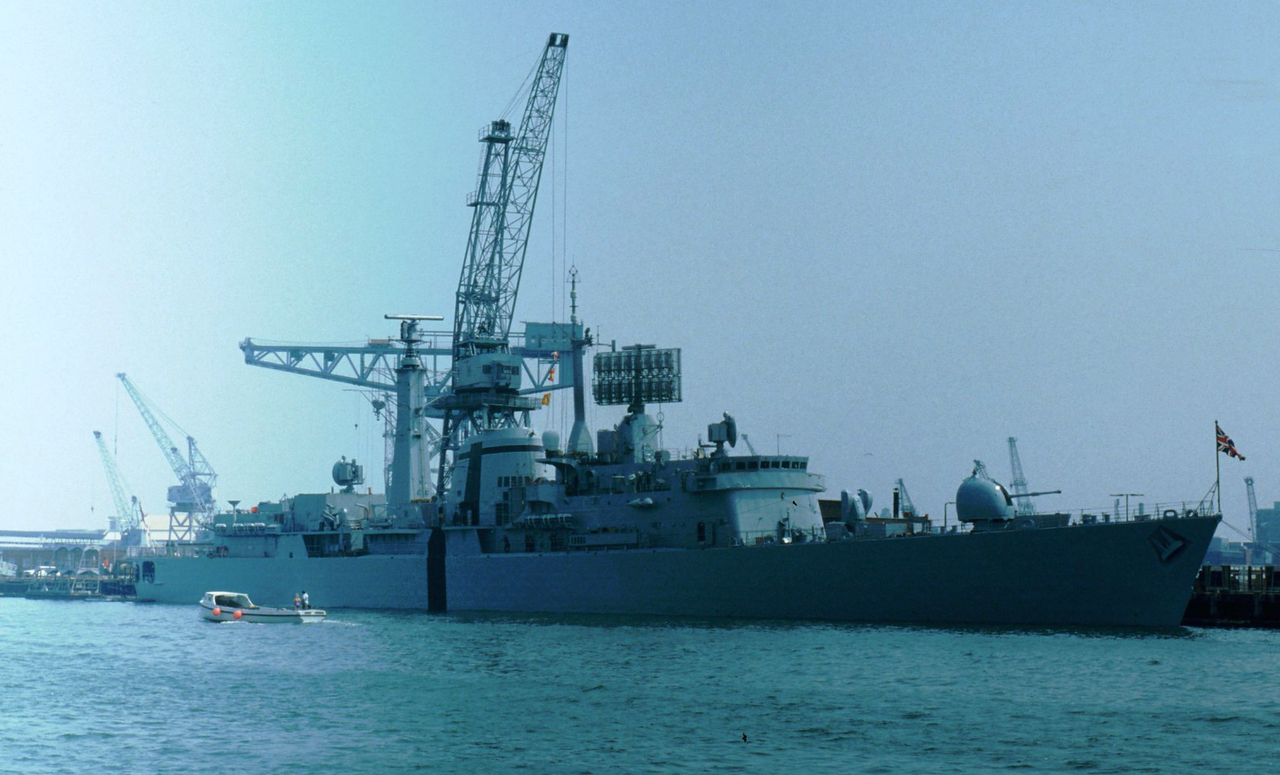
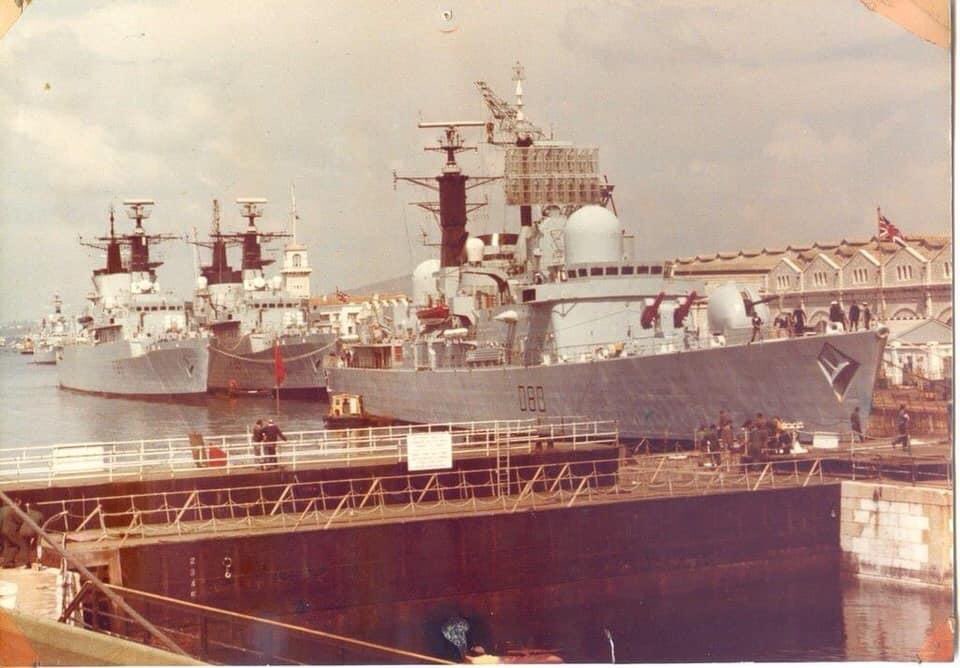
 g
g
Sources:
Spoiler
Books:
British Destroyers & Frigates from second World War and after-Norman Friedman
One hundred days- Sandy Woodward
Royal Navy destroyers since 1945 - Leo Marriot
Sites:
Type 42 destroyer - Wikipedia
Sheffield class Type 42 Guided Missile Destroyer - Royal Navy
Sea Dart - Naval Missiles of the United Kingdom/Britain - NavWeaps
Britain 4.5"/55 (11.4 cm) QF Mark 8 Mod 0 and Mod 1 - NavWeaps




























g